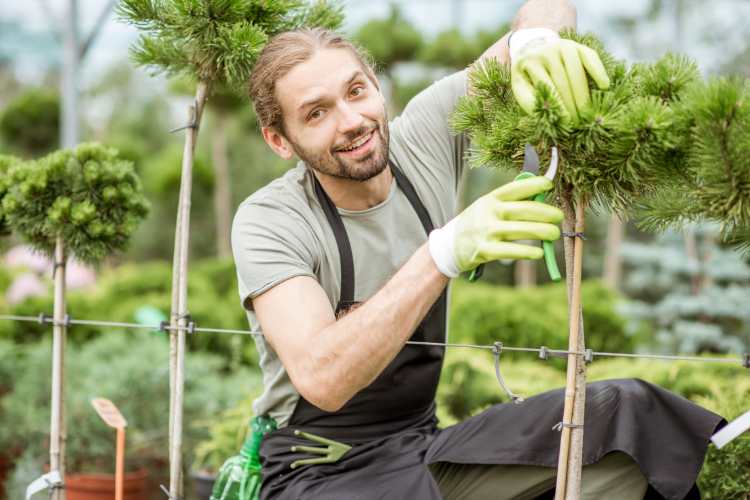10 Tips for Caring for Ornamental Trees
12th Mar 2023
A firm favourite with gardeners, ornamental trees make an attractive feature in any garden but not only that. They can add interest and colour all year round but can also be used for screening, shade and also provide a habitat for wildlife.
I’m generalising there of course but there are so many different trees to choose from including evergreens and fruit trees. You can see our full range of ornamental trees here but one of the other great things about them is that they are usually straightforward to grow and maintain.
Nevertheless, there are a few ways in which you can ensure all your trees are a great success so we’ve put together a few tips for you to follow.
Our top 10 tips for caring for ornamental trees
1: Choose your tree wisely
Ok, let’s start at the beginning. Take a little time to decide which tree or trees you’re going to plant and where you will plant them. You obviously need to choose a tree that will thrive in your garden’s soil and think about where you will position the tree. Does it need full sun or will it be OK in the shade?
On the Direct Plants website you’ll find all the information you need in our product listings to decide whether the tree you choose will be good for your garden.
Even if your garden has poor quality soil you can plant your ornamental trees in pots. You can also choose between a standard tree or dwarf ornamental trees.
You should also think about the tree's mature size, shape, and growth rate, as well as its natural resistance to pests and diseases.
2: Water well
Water the tree well before planting but once established your tree will still need to be well-watered especially during hot and dry weather. Water at the base of the truck rather than through the foliage and water deeply.
If you’re growing your tree in a pot, check regularly because the soil can quickly dry out. But you also do need to take care not to over water your potted plants as they can become waterlogged so it is a bit of a balancing act when watering trees in pots.
3: Mulch around the tree
Mulching helps retain moisture, suppresses weeds, and ultimately will improve the quality of your soil. There are so many different types of mulch you can use but you can put down a layer of wood chips or bark, to a depth of 2-3 inches. A word of caution here: be careful not to pile the mulch up against the tree's trunk which can cause rot.
4: Prune regularly
I don’t know about you but I don’t enjoy pruning. Nevertheless I know it’s important and that regular pruning will not only keep the tree looking good it will help to keep it healthy. You should of course prune the tree when it's dormant in late winter or early spring and it’s always best to prune the tree when the weather is dry. Make sure you keep your tools sharp so you don’t damage the tree when cutting.
5: Fertilise the tree
Some gardeners don’t use fertiliser at all. But it can be beneficial if applied in early spring. Use a balanced fertiliser - there are many different brands to choose from and you may already have a favourite you use all the time. Sprinkle the fertiliser on and around the root area and gently work it into the soil using a hoe or similar tool.
Fertilising is especially beneficial if the tree is still establishing itself or was damaged over winter. After pruning is a good time to apply the fertiliser.
Be careful to follow the manufacturer's instructions when using a fertiliser. Using too much could damage the tree’s roots. Apply the fertiliser when the soil is moist and it’s usually best to avoid fertilising the tree when the weather is hot and dry.
6: Protect the tree from pests and diseases
Always a problem and we’re very fortunate if we get through a season without at least some plants and trees being blighted by pests. It comes with the territory of course and whilst it isn’t easy to prevent pest infestation tackling it quickly will minimise the damage.
There are plenty of pest control sprays and treatments available including organic solutions. Make sure you keep a supply in your greenhouse or shed and every spring you should replenish your sprays and ditch any that are out of date.
7: Provide support for young or weak trees
When first planted, whether in the ground or in a container, your ornamental tree may need support to ensure it grows straight and strong. Use wooden or powder coated metal stakes with ties to anchor the tree. When applying the ties be careful to avoid buds and foliage. The support can be removed once the tree is strong enough to support itself. This will usually be after a year or two.
8: Keep the planting area clean and tidy
It’s a bit of a chore but keeping the area around the tree tidy and free from debris can go some way towards preventing pests and disease. And of course it ensures the tree will always look its best. So clear away any fallen leaves, branches, and any other debris the wind has blown around the tree.
9: Monitor the tree's health and growth
Regularly checking the tree for damage, pests, and growth is your early warning system for spotting potential issues or for getting early notice of problems. Check the bark for cracks or wounds and the foliage for signs of wilting or discolouration.
10: Protect the tree during extreme weather
There is nothing as ridiculous or as unpredictable as British weather. Although all the trees we sell are fully UK hardy extreme weather can still have catastrophic effects on your ornamental trees.
In the UK we can suffer drought, snow, heavy rain, and stormy winds. Often within the space of a few days. You need to be resilient to be a British gardener.
During long periods of dry, rain free weather make sure your tree is getting enough water to keep the soil moist. Keep a close eye on any potted trees as hot weather will very quickly dry out the soil.
March and April in particular can be prone to high winds but such is the vagaries of our climate they could happen at any time. Winds can be a treat to newly planted or very young ornamental trees. Making sure they are correctly staked will help as will positioning them in a sheltered spot when planting. One advantage of potted trees is that they can be moved in the event of strong winds.
In the event of cold weather and before the winter season arrives make sure you give the tree a good watering. You can protect the tree against frost by wrapping the truck in bubble wrap or horticultural fleece. Finally cover the root area with plenty of mulch.
Although we’ve listed ten tips here, the good news is that caring for ornamental trees isn’t too difficult a job. Even novice gardeners will enjoy great results and get so much enjoyment from planting trees in their garden.
These trees make wonderful focal points and every time you look out at your garden you’ll have a smile on your face.


